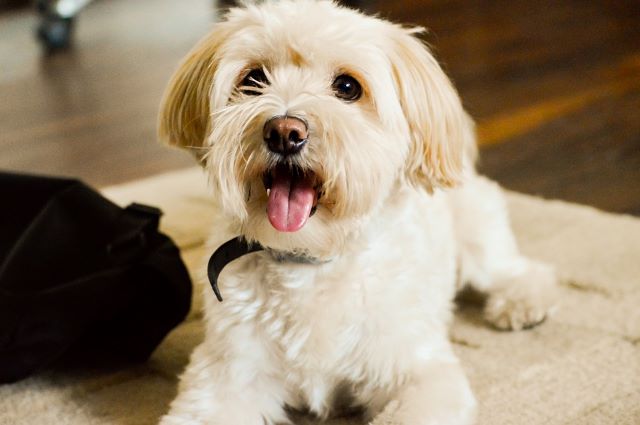If you’re in the market for an outgoing, playful, loyal dog, the Cavapoo is likely a great fit for your family! Cavapoos (Cavoodles) are a crossbreed between Cavalier King Charles Spaniels and Poodles. This mix results in an undeniably cute, curly-coated dog with the best of both breeds. But like all dogs, Cavapoos come with common health problems to keep an eye out for.

Cavapoo health issues to look out for include:
- Mitral valve disease
- Cataracts
- hip dysplasia
- Hernias
- Progressive Retinal Atrophy
- Syringomyelia (SM)
- Luxating Patella
- Skin Issues
- Epilepsy
Cavapoo Health 101
Unlike purebred dogs, mutts and mixed breeds lack many of the usual genetic issues that come with pure breeding practices. But that doesn’t mean your Cavapoo will never have a health problem. This is why we’ve brought together the 9 most common health issues that Cavapoos experience.
In general, Cavapoos can inherit brain, heart, and eye problems from their parents of either breed. You’ll notice that many of them are issues that humans can also inherit.
Some of these health issues can be prevented by purchasing your Cavapoo puppy from a responsible breeder. They will DNA test their breeding parents to ensure hereditary diseases are not passed on to the litter. You can ask to sight the results.
Keep in mind that this is a list of possibilities, not guarantees. All dogs, no matter the breed, face health problems at some point in their life. We’re here to help you prepare for your pet’s health by being knowledgeable!

1. Mitral Valve Disease
In most dogs, not just Cavapoos, mitral valve disease is an early indication of heart disease. Around 1 in 10 dogs will develop heart disease during their life. And the majority is caused by mitral valve weakness.
Mitral valve disease happens when pressure in the left ventricle of the heart weakens the valve. This can lead to leaks within the heart. There are other, less common causes of mitral valve disease, but the earliest sign is usually a heart murmur.
The best way to prevent or treat mitral valve disease and the heart complications that can follow is to schedule your dog for regular check-ups. The vet will listen to their heart and catch any murmurs ahead of time. If this is the case, X-rays, blood and urine tests, and electrocardiograms will likely be performed to assess the situation.
Long-term and preventative treatment includes various medications and low-sodium diets. Most dogs diagnosed with mitral valve disease will require lifelong care. However many dogs also stabilize quickly once on medication and can live their lives with good quality.
2. Cataracts
Like humans, dogs can also get cataracts, which are clouding over the lens of the eye. It can lead to partial or full vision loss if not treated. If hereditary, cataracts can affect dogs as young as 1 year old.
Symptoms include changes in eye color, cloudy pupils in one or both eyes, general clumsiness, and difficulty seeing. These changes will probably be obvious if you know your dog well and spend time with them.
The best option for your Cavapoo if they develop cataracts is surgical treatment, much the same as in people. But unlike humans, dogs don’t necessarily understand what the issue they’re dealing with is. So your pet should be watched closely after surgery to make sure they don’t irritate or scratch their eyes.
Cataracts surgery ranges in price from $1500 to $5000, and is one of the more expensive health problems that these breeds deal with. Keep in mind that this isn’t just a health issue for older dogs!
3. Hip Dysplasia
You might be surprised to see hip dysplasia on this list, as it’s usually associated with purebred, larger dogs. But this is a common condition inherited from the Poodle side of the parentage.
Hip dysplasia is caused by joints in the hip rubbing and grinding together, which eventually leads to pain and weakness. You may notice your pup start to slow down a bit, limp, or have trouble getting around (going upstairs, jumping, or even just walking).
If your dog has any of the above symptoms, restrict their activity as soon as possible and schedule an appointment with your vet. Because hip dysplasia can happen in dogs as young as four months old, a good preventative is Glucosamine supplements like these, which support joint health.
If the condition has gotten bad enough to require treatment, your Cavapoo will likely need to have their exercise restricted, start taking anti-inflammatory meds, or even have surgery.
4. Hernia
Hernias occur when fatty tissue or an organ is squeezed through a weak spot in the muscle, leading to a bulge, swelling, and occasionally pain.
Unfortunately, hernias are common in Cavalier King Spaniels, and therefore one of the most likely health problems for a Cavapoo to face. The good news is that hernias can be repaired with a simple surgery that costs, at most, $500.
Hernias vary in terms of urgency, and your vet will be able to give you a better idea of whether or not treatment needs to happen immediately. There is no real way to prevent hernias in dogs as they are either congenital or occur spontaneously. The best thing you can do for your Cavapoo pup is keep a close eye on them and know what the “normal” lumps and bumps are.
5. Progressive Retinal Atrophy
In PRA, the photoreceptor cells in a dog’s eyes begin to deteriorate, eventually leading to blindness. PRA can be inherited or “early onset,” ranging in appearance in dogs from age 2 months to 9 years.
Unfortunately, being a mixed breed doesn’t stop Cavapoos from inheriting this degenerative disease. Cavalier Spaniels are one of the breeds commonly affected with PRA.
One of the first symptoms of PRA is night blindness; your dog may be nervous during the evening and bump into things. There is no effective treatment for PRA to date, however if caught early the condition can be managed somewhat.
6. Syringomyelia
Often abbreviated as SM, this condition results in fluid build-up in spinal cord cavities. The Cavalier Spaniel side of the Cavapoo can lead to SM, as Cavalier’s have small skulls that result in pressure on the spinal cord.
Symptoms of SM are very obvious. Your Cavapoo dog may be extremely sensitive to any touch on their neck, chest, head, and shoulder area. They may hold their head oddly to prevent pain and even sleep with their head up. If your pup is young and inactive based on their age or usual personality, this may be a warning sign that they are uncomfortable.
SM can appear in dogs as young as 6 months of age and is painful, requiring drugs and possibly surgery to help mitigate the symptoms. Physical therapy is also an option and can often be done by the owners themselves if they are willing to learn!
7. Luxating Patella
Although it might sound complicated, a luxating patella is simply a kneecap that is out of place. Dogs who have luxating patellas may skip or choose not to use the affected leg occasionally. Because they will often revert to walking on all four legs, some dog owners dismiss the issue.
Most dogs affected by luxating patellas are small breed and have a genetic predisposition, but it is common in Cavapoos as well. The makeup of their legs allows the kneecap to slide out of place and cause abnormal movement. There are rarely signs of pain in dogs who have luxating patellas.
Many dogs live a quality life with patella luxation and aren’t often bothered by the condition. More extreme cases may require surgery if your Cavapoo is persistently lame or other injuries occur in conjunction with the slipping patella.
The prognosis for most dogs is excellent as long as you are aware of the issue and see your vet in a timely manner.
8. Skin Issues
Cavapoos can experience sebaceous adenitis, which is a skin disease that affects the glands responsible for skin health in dogs. Dogs suffering from sebaceous adenitis have scaly skin and waxy hair that mats easily – so you will notice the symptoms quickly!
Unfortunately, sebaceous adenitis is a life-long condition, so there’s no cure; but it can be easily managed with regular bathing and a medicated shampoo like this one.
9. Epilepsy
While epilepsy might seem frightening at first, it can be explained as spontaneous seizure activity (in both humans and dogs). Both Poodles and Cavalier King Charles Spaniels deal with epilepsy, making the chances of your mix-breed dog higher for developing this issue.
As of yet there have been no specific causes identified for epilepsy in dogs. Often, mild cases of seizure-like activity don’t need treatment and can simply be monitored by the pet owner for any changes.
In more severe cases, your pet may need to be on medication for the duration of its life, and this expense should be taken into consideration.
Conclusion
Doing your research ahead of time is an integral part of deciding to add a pet to your family. Cavapoos are cute, outgoing, loyal breeds that will give as much love as they receive!
Most responsible breeders will DNA test their breeding parents to ensure they won’t be passing on any preventable hereditary diseases and health problems. So be sure to check this to ensure your puppy is healthy.
Like all dogs, Cavapoos come with common health issues to keep an eye out for. In general, they are inexpensive to prevent or treat if caught early. The most important thing you can do as a pet owner is be aware of your pup’s actions, be familiar with what is “normal” for them, and be willing to contact your vet at the first sign of abnormal symptoms.

- What Is A Cavapoo Dog? (And is this breed right for you)
- Are Cavapoos (Cavoodles) Hypoallergenic? Answered!
- Do Cavapoo Dogs Make Good Apartment Dogs?
- Cavapoo Coat Types And How To Care For Them
- Why Do Cavapoos Lick So Much? Answered!
- Why Does My Cavapoo Smell? How To Make It Smell Better?
- What To Do If Your Cavapoo Is A Picky Eater
- The Average Life Expectancy Of Cavapoo Dog (Toy and Mini)
- Cavapoo Dog Bed Size Guide (Puppy to Fully-Grown)
- 16 Deep Chested Dog Breeds & Health Risks
- Will Male Dogs Mate With Their Offspring? (Is It Safe?)
- Cockapoo Vs. Cavapoo: Differences Explained
